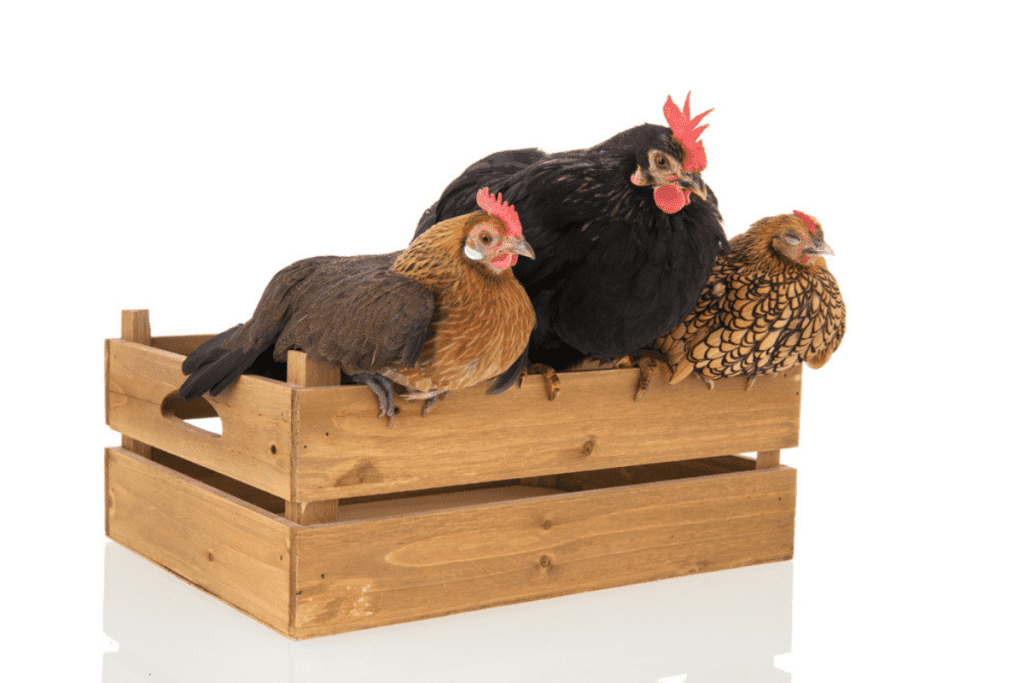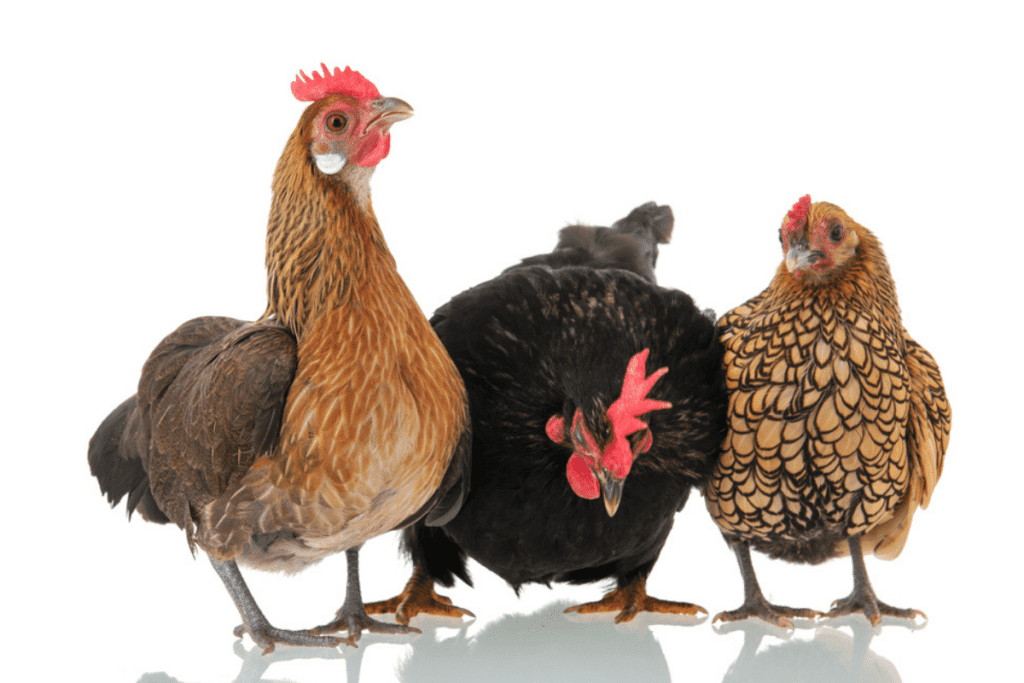Sebright chickens are some of the most adorable birds on the market.
But as chicken parents, we usually worry about a lot more than appearances when we purchase new birds to add to our coop.
Sebrights are beautiful, spunky hens, and it’s important to learn everything possible about them before you add any of these girls to your chicken coop.
This is especially true if you primarily raise layers.
Keep reading to learn all there is to know about the eggs and laying habits of the Sebright breed.

Table of Contents
ToggleAre Sebright Hens Good Layers?
Sebright hens lay eggs but are not exactly what you call abundant egg layers. Producing less than 100 eggs per year, they are well behind most other varieties of poultry in the laying department. Sebrights are bad egg layers.
Sebright hens are bantam chickens and do not have a non-bantam (or full-size) counterpart, unlike most bantams.
Therefore, how few eggs they lay in a year is not altogether surprising.
However, it is understandably disappointing if you aren’t aware of what you’re getting into when you buy your birds.
Expecting prolific egg layers and witnessing the low production of a Sebright hen is certainly not a positive experience.
The same is true for meat production.
Whereas larger birds are usable as meat birds if their laying is not up to snuff, Sebright hens are too small for this purpose.
This being said, Sebright has a lot to offer.
Don’t write this beauty off because she isn’t used for commercial egg production.
What Do Sebright Eggs Look Like?
Being a true bantam, Sebright hens’ body size means they always lay small eggs. Their eggs are white, though sometimes tinted, in color. They do not change in appearance with the color variations of the bird herself.
A Sebright hen with dark gold feathers will not lay an egg of a different color variety than a Silver Sebright.
These are the only two officially accepted color descriptions by the American Poultry Association.
The only difference between them is in the appearance of their distinctive plumage, as they both lay small, white eggs.
None of these is a better egg layer than the other, either. Both require the same conditions and start laying at the same time.
When Do Sebright Chickens Lay Eggs?
Sebright chickens start laying between 16-22 weeks of age. However, their environment heavily influences whether or not they lay. If the climate is too hot or cold, they will not lay until it is more comfortable.
If your Sebright pullets reach laying age before Spring, do not expect any eggs until it warms up.
Looking for chicken breeds who lay in poor weather conditions?
Consider moving away from bantam birds like the Sebright.
This is a dynamic bird but generally is seen as exhibition poultry.
Their personalities and appearance make Sebright hens and roosters well-suited for competitive poultry exhibition standards.
This being said, it is not uncommon to keep Sebrights among a flock of layers for their appealing personality and beautiful plumage.
How Long Do Sebright Chickens Lay Eggs?
The average lifespan of a Sebright chicken is about 8 years. However, they tend to lay almost exclusively in Spring. Their laying also slows considerably after a few years, a common experience among laying hens of all kinds.
What sets Sebrights apart from most laying hens and even many bantam breeds is their inability to lay for about 75% of the year.
Most Sebright hens begin laying for the year when the weather improves in Spring.
But once temperatures climb in the summer, this breed of chicken will quit laying again.
How Often Do Sebright Chickens Lay Eggs?
During their laying season, Sebright hens lay eggs rather frequently. Usually, they produce one egg every other day, though sometimes their laying is more sporadic. The more stable the climate is, the better the laying conditions, which helps Sebrights keep steadily producing eggs while the weather permits.
For comparison, consider the Plymouth Rock hen.
She lays about one egg every other day as well.
However, the Plymouth Rock lays for most of the year, making her total yearly egg production (200 eggs) much higher than the Sebright’s.
If it’s too cold, they may stop laying as often.
Further Reading: Are cochin chickens cold hardy?

Do Sebright Hens Go Broody?
Sebright hens are not very broody. They cannot sit for weeks on a clutch of eggs until they hatch, nor do they make good mothers once the chicks have hatched. Sebright chicks have a low hatch rate and a high mortality rate.
Some chicken keepers dabble in breeding and like to raise show birds from egg to adult.
Sebrights are difficult to hatch, making them a hard bird to breed and hatch yourself.
We would recommend finding a reputable breeder and talking to others who have bought Sebright eggs or baby chicks from them before making your purchase.
This will ensure your eggs have the best chance of hatching or your chicks have the best chance of survival.
If you decide to fertilize your Sebright hen’s eggs and hatch them yourself, use an incubator instead of hoping for a Sebright to keep those eggs warm.
Maybe you have a hen of another breed who is particularly broody and would sit on the eggs for you. Just make sure your method is reliable.
Hatching this breed of chicken is no easy feat.
Do Sebright Hens Sing the Egg Song?
Sebright hens sing their egg song when they prepare to lay an egg. This is one way to recognize whether they are about to begin laying in the Spring or even as pullets. Remember, though, in a lovely flock of backyard chickens, hens will often sing the egg song to cheer each other on.
You may hear your Sebright singing this song to benefit a Rhode Island Red or other chicken breeds in your coop.
Regardless, this song means you’ll be getting an egg soon!
How to Improve Egg Production in Sebright Hens
Even with a balanced diet, readily available clean water, and plenty of space to roam, Sebright hens are finicky layers. Without the proper environmental conditions, they won’t lay. If they aren’t laying, even during the season, they usually would start with the basics.
Sebrights are big flyers, so you must have plenty of space for them to run around and flap their wings.
If you have the resources, put roosts in your chicken yard and let them fly up and hang out above your head.
Otherwise, just be prepared to find them perched on the roof of your chicken coop!
Things like overcrowding and lack of good feed or fresh water are often the culprit for decreased egg production.
Make sure your hens aren’t frequently running out of food or water before you get to the coop in the morning or night.
If none of these is the problem, consider changing chicken feeds to something with higher protein or calcium content.
Both of these nutrients are important to your layers.
The poultry experts at the American Poultry Association also suggest working to help your birds destress if you like to show them.
High stress sometimes leads to trouble laying.
If stress is disrupting your Sebright’s egg production, it is reaching an unsafe point where other health issues may also start to arise.
Unfortunately, Sebright chickens are particularly vulnerable to a deadly illness called Marek’s Disease.
You will likely see other symptoms in your bird(s) if they suffer from this illness.
Some symptoms to look out for include:
- Labored breathing
- Depression & decreased activity
- Sight problems & blindness
- Lesions
If you see these or other signs of sickness, it’s important to consult with a veterinarian and get their opinion on your chicken’s condition.
More About the Sebright
A British poultry breed developed by its namesake, John Sebright, the Sebright chicken is unique and enjoys a loyal following. While they are excellent chicken for competitions, a Sebright is not the chicken of choice for beginner chicken keepers or those who focus primarily on meat or egg production.
Despite its penchant for flying and adventuring, the Sebright is not an aggressive or especially jumpy bird.
Many people who have worked with this breed, whether as exhibition poultry or as feathered friends, say Sebrights are affectionate birds with lovely individual personalities.
Their distinctive plumage makes them stand out in the best way as charming birds at exhibitions, whether you have the Silver Sebright or her gold-feathered counterpart.
Because of the Sebright’s heightened vulnerability to Marek’s disease, which is contagious, we recommend you be especially careful bringing new birds of this breed into your healthy flock.
This is a good rule of thumb, but Sebright’s caution is extra important.
This is especially important if you purchase adult chickens rather than baby chicks or unhatched eggs.
While Sebright birds are more susceptible to catching this disease, it is a serious illness for any chicken who contracts it.
How useful was this post?
Click on a star to rate it!
We are sorry that this post was not useful for you!
Let us improve this post!
Tell us how we can improve this post?
